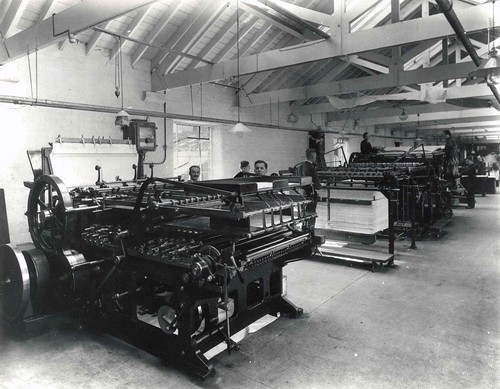
Having already published schemes to help the printer cost his work and provide accurate estimates, the British Federation of Master Printers turned it’s attention to office procedure and in 1965 produced Printing Office Procedure, a six-volume work to train those new to printing offices in the details of administering the work that passed over their desks. Volume 1 also includes a description of the state of the printing industry at that time. This article looks at the way the industry worked.
Before we look at printing, it’s worth getting a flavour of what Britain was like in 1965. Things look optimistic: the Post Office Tower opens, the miniskirt is sold by Mary Quant, the Government looks at introducing a drink-drive alcohol limit and the death penalty for murder is abolished. In terms of the printed word, the vast majority of what you’d see is still printed by a printer: the only practical means of getting words on a page for the public is to hand-write or use a typewriter.
There were 4,000 firms in the British Federation of Master Printers (the employers’ organisation). The size of the firm was generally small: 40% of those firms employed fewer than ten people; 22% fewer than 24 people. Some 220,500 staff were employed in the industry, but most were engaged by firms between 100 and 500 people in size. At the top end, only 60 firms had more than 500 people and just 20 had more than 1,000 staff.
Printing was predominantly letterpress, with offset lithography beginning to make advances that would see it eclipse letterpress commercially. More than 3,500 of the 4,000 firms were ‘mainly letterpress’. Because phototypesetting and computer typesetting were very much in their infancy, where printers did want to print offset they needed a letterpress original. This is a curious period in printing where a very precise letterpress process was used to generate a copy that could be photographed to make a litho plate. Only 10% of the firms were ‘mainly litho’, the remainder being photogravure. Some printers had more than one process in-house and some used additional processes: collotype, die-stamping, flexographic printing, for example.
The report notes that “Every town in Great Britain of reasonable size is served by a number of smaller printers, originally established to meet the demand for general printing in their own locality”. There are some significant exceptions, however, where specialised processes or centres are established to serve one particular market. There was also a tendency to move away from the centre of cities since World War II when damage to buildings forced some firms to relocate to other areas.
Stepping back at little and looking at these numbers, it’s easy to see that a great secondary industry was needed to support these businesses and employees. While paper consumption may have changed little, it’s the ink makers, printers’ engineers and furnishers, press makers and type founders that would have relied on that mass of letterpress printers.
In terms of organisation, the industry was governed by a number of organisations — knowing that they had been under some sort of organisation since Elizabethan times. Employers were grouped in the Newspaper Proprietors’ Association and general printers in the British Federation of Master Printers. Employees unions were grouped in to the Printing and Kindred Trades Federation with 386,000 members.
Printers were still keen to secure the best advice to improve the process and PIRA, the research organisation for the paper and board, packaging and printing, filled this role. It was funded by ‘voluntary subscriptions’ from firms but also a Government grant. They offered technical support and carried out their own research with physical, chemical, biological and mechanical testing expertise.
Education was something encouraged by employers and employees alike. There were three major routes in to the industry: a traditional apprentice with release to study part-time; entry to the office with qualifications from the BFMP; and finally full-time study at one of the many local specialised technical colleges. The key colleges being London College of Printing, Manchester College of Art and Design, Leeds College of Technology, Watford College of Technology, Edinburgh’s Napier Technical College and Glasgow College of Printing. The Institute of Printing was a body to set standards for examinations in the craft side of the industry.
This ends our look at 1965: letterpress was still dominant, hundreds of thousands of people worked in the industry all supported by a vast web of suppliers and manufacturers and printing was done locally in your own town.

